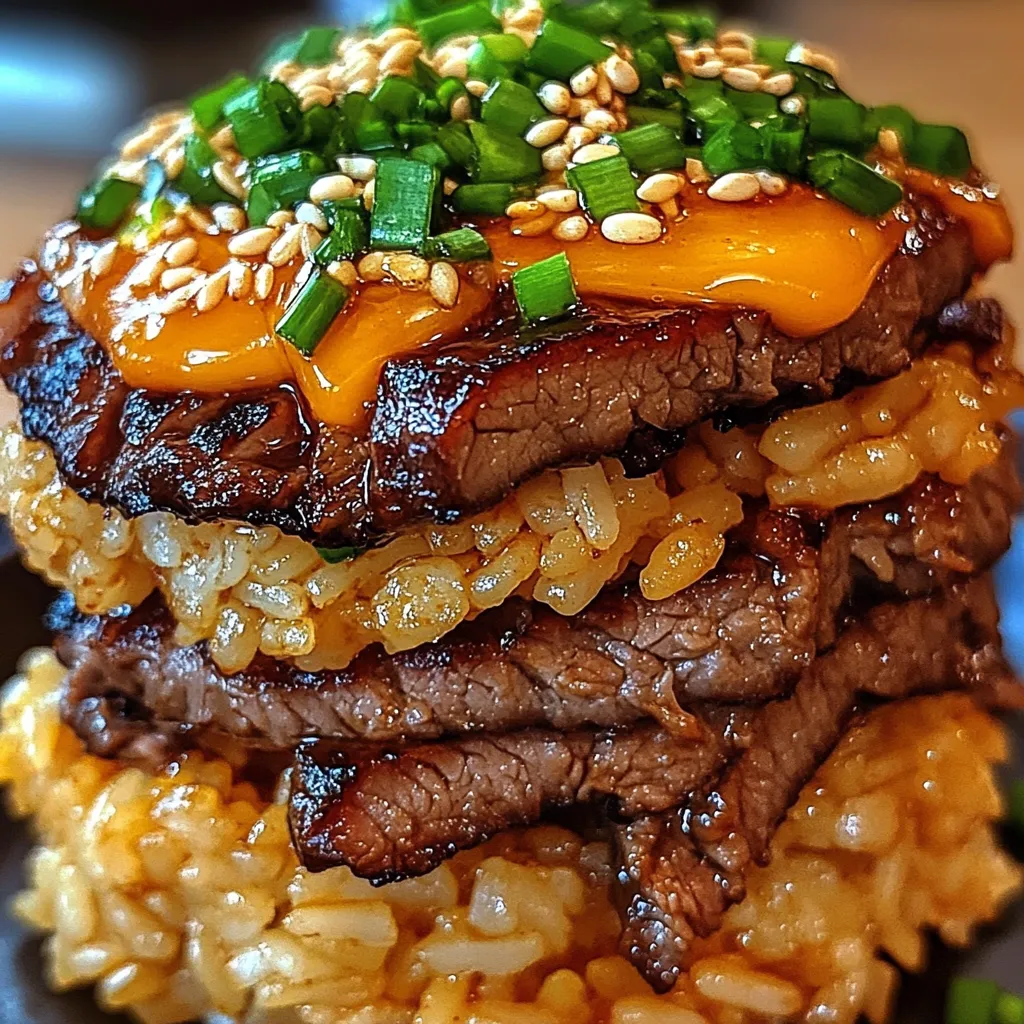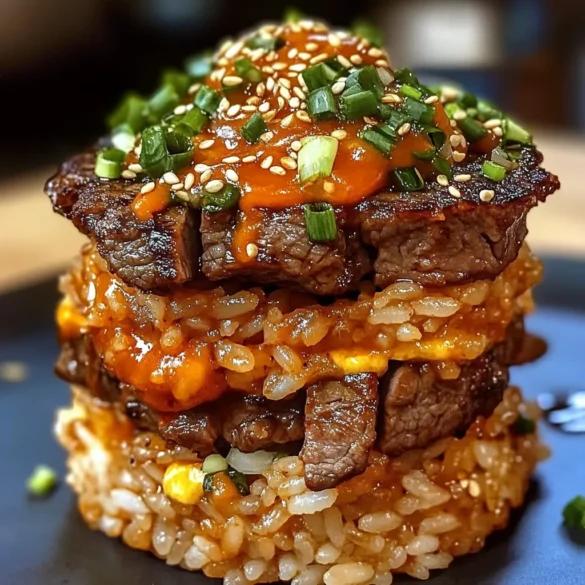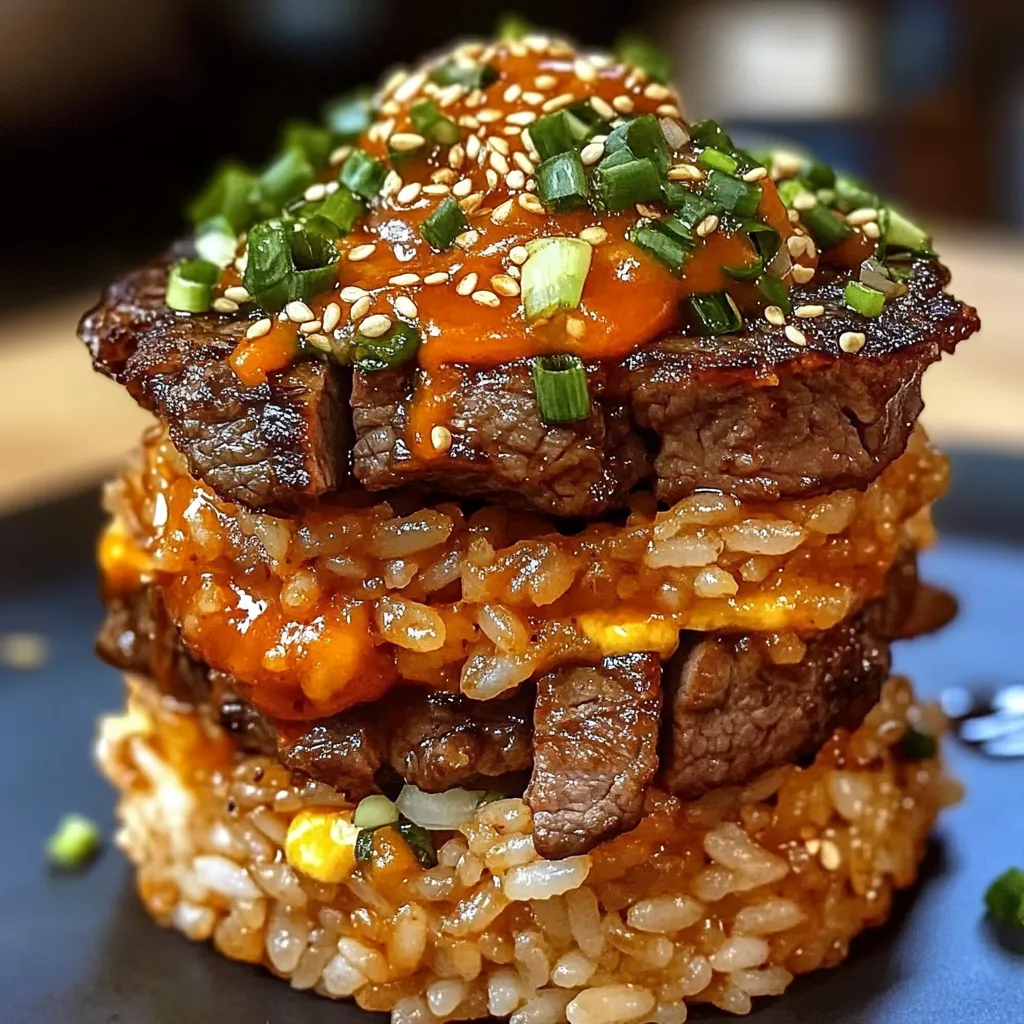This extraordinary Epic Korean BBQ Beef Rice Stack represents the pinnacle of Korean-fusion cuisine, transforming traditional bulgogi flavors into a spectacular layered presentation that combines tender, marinated beef with perfectly seasoned rice and vibrant Korean condiments, creating a dish so visually stunning and deliciously complex it bridges the gap between street food comfort and fine dining sophistication while delivering an explosion of umami-rich flavors that celebrate the best of Korean culinary tradition. The recipe masterfully layers components to create architectural beauty—crispy, golden rice forms the foundation that provides textural contrast and nutty flavor, while succulent Korean BBQ beef marinates in a complex blend of soy sauce, sesame oil, garlic, and Korean pear that creates the signature sweet-savory profile, all topped with vibrant garnishes that add color, freshness, and authentic Korean flavor elements. Every bite delivers a symphony of Korean tastes and textures—the caramelized rice provides satisfying crunch and toasted grain flavors while the tender beef offers rich umami depth enhanced by traditional Korean seasonings, and the fresh garnishes contribute bright acidity and aromatic complexity that creates perfect balance and authentic Korean dining experience. The dish’s visual appeal showcases dramatic vertical presentation with golden rice towers supporting glossy, caramelized beef and colorful garnishes of sesame seeds, scallions, and Korean chili sauce, creating an Instagram-worthy presentation that proves fusion cuisine can honor traditional flavors while pushing creative boundaries. This innovative creation embodies modern Korean-fusion cooking at its most exciting—perfect for impressing dinner guests, celebrating special occasions, adventurous home cooking, or anytime you want to experience the bold, complex flavors of Korean cuisine presented in a completely new and visually spectacular way.
Why You’ll Love This Recipe
- Fusion innovation: Combines traditional Korean flavors with creative presentation
- Visual impact: Creates restaurant-quality presentation that impresses every guest
- Bold flavor profile: Delivers authentic Korean umami richness and complexity
- Textural variety: Combines crispy rice, tender beef, and fresh garnishes perfectly
- Instagram-worthy: Stunning vertical presentation perfect for social media sharing
- Customizable heat: Easily adjust spice levels to suit all taste preferences
- Make-ahead components: Rice and beef can be prepared separately for easy assembly
- Authentic Korean elements: Uses traditional ingredients for genuine flavor experience
- Comfort food elevation: Takes familiar ingredients to gourmet presentation level
- Conversation starter: Unique dish that sparks curiosity and culinary discussion
Ingredients
For the Korean BBQ Beef
- Ribeye or sirloin beef – Provides tender texture and rich flavor for authentic bulgogi
- Thinly sliced against grain – Essential for proper texture and easy eating
- High-quality cuts preferred – Make significant difference in final tenderness
- Partially frozen for slicing – Easier to achieve paper-thin uniform slices
For the Traditional Korean Marinade
- Soy sauce – Forms salty umami base essential for authentic Korean flavor
- Korean pear or Asian pear – Provides natural sweetness and tenderizing enzymes
- Sesame oil – Adds distinctive nutty aroma and authentic Korean character
- Fresh garlic cloves – Contribute aromatic intensity and savory depth
- Fresh ginger – Provides warm spice and traditional Korean flavor complexity
- Brown sugar – Balances salty elements and aids in caramelization
For the Crispy Rice Foundation
- Short-grain white rice – Creates proper sticky texture for molding and stacking
- Day-old rice preferred – Provides better texture for frying and prevents mushiness
- Vegetable oil for frying – Neutral flavor allows rice and seasonings to shine
- Sesame oil for finishing – Adds authentic Korean nutty flavor and aroma
For the Korean Flavor Enhancers
- Gochujang Korean chili paste – Provides signature heat and fermented complexity
- Rice vinegar – Adds bright acidity that balances rich, heavy elements
- Mirin or cooking wine – Contributes subtle sweetness and depth
- Korean corn syrup or honey – Creates glossy finish and balances spice
For the Fresh Garnish Elements
- Fresh scallions – Add bright color and mild onion flavor contrast
- Sesame seeds – Provide nutty crunch and traditional Korean garnish appeal
- Korean nori sheets – Optional garnish for additional umami and texture
- Fresh cilantro – Adds bright, fresh contrast to rich, savory elements
For the Sauce Components
- Additional soy sauce – For finishing and extra umami depth
- Sriracha or Korean chili oil – Adjustable heat element for personal preference
- Lime juice – Brightens flavors and adds acidic balance
- Fish sauce optional – Enhances umami complexity for authentic depth
Optional Gourmet Additions
- Kimchi – Traditional fermented vegetables for authentic Korean experience
- Korean pickled vegetables – Add tangy crunch and traditional appeal
- Fried garlic – Provides aromatic intensity and textural interest
- Toasted seaweed – Adds oceanic umami and authentic Korean flavor
- Korean cheese – Modern fusion element for creamy richness
- Soft-boiled egg – Adds protein and creamy richness to complete the stack
Step-by-Step Instructions
Preparing the Perfect Korean BBQ Beef
- Select 1 pound high-quality ribeye or sirloin steak and place in freezer for 30-45 minutes until partially frozen, making it easier to slice paper-thin against the grain.
- Using sharp knife, slice beef against the grain into ⅛-inch thick strips, ensuring uniform thickness for even cooking and optimal tenderness in the finished dish.
- For the marinade, grate 1 medium Korean pear (or Asian pear) using fine grater, extracting both pulp and juice for natural sweetness and tenderizing enzymes.
- In large bowl, combine grated pear with ¼ cup soy sauce, 2 tablespoons sesame oil, 4 minced garlic cloves, 1 tablespoon minced ginger, and 2 tablespoons brown sugar.
- Add sliced beef to marinade, using clean hands to massage marinade into meat thoroughly, ensuring every piece is well-coated for maximum flavor absorption.
- Cover and refrigerate for minimum 2 hours or up to overnight, allowing enzymes and acids to tenderize meat while flavors penetrate deeply into beef.
Creating the Crispy Rice Foundation
- Use 3 cups day-old cooked short-grain rice, breaking up any clumps gently with wet hands to create individual grains that will crisp properly during cooking.
- Heat 2 tablespoons vegetable oil in large non-stick skillet over medium-high heat until shimmering, creating proper temperature for crisping without burning.
- Add rice to hot oil in even layer, pressing down gently with spatula to create compact surface that will develop golden crust during cooking process.
- Cook undisturbed for 4-5 minutes until bottom develops golden-brown crust, resisting urge to stir or move rice prematurely for optimal crisping.
- Flip rice in sections using spatula, cooking additional 3-4 minutes until crispy and golden on both sides, creating textural contrast essential for dish.
- Season with salt and drizzle with sesame oil, tossing gently to distribute flavors while maintaining crispy texture and golden color.
Cooking the Marinated Korean Beef
- Remove beef from marinade, reserving marinade liquid for sauce preparation, and allow meat to come to room temperature for 15-20 minutes for even cooking.
- Heat large skillet or wok over high heat until smoking, creating intense heat necessary for proper searing and caramelization of marinated beef.
- Add marinated beef in single layer, working in batches if necessary to avoid overcrowding that would cause steaming rather than searing.
- Cook undisturbed for 2-3 minutes until bottom develops caramelized crust, then stir-fry quickly for additional 1-2 minutes until just cooked through.
- Add 2 tablespoons reserved marinade to pan, allowing it to reduce and glaze the beef while creating glossy, flavorful coating that clings to meat.
- Remove from heat immediately to prevent overcooking, as beef should remain tender and juicy while developing beautiful caramelized exterior.
Preparing the Korean Sauce Elements
- In small saucepan, combine remaining reserved marinade with 1 tablespoon gochujang, 1 tablespoon rice vinegar, and 1 teaspoon Korean corn syrup or honey.
- Bring mixture to gentle simmer over medium heat, whisking constantly to ensure smooth consistency and prevent burning of delicate ingredients.
- Simmer for 3-4 minutes until sauce reduces slightly and achieves glossy consistency that will coat rice and beef beautifully during final assembly.
- Taste and adjust seasonings, adding more gochujang for heat, vinegar for acidity, or sweetener for balance according to personal preference and desired flavor profile.
- Strain sauce through fine-mesh sieve if desired for smooth consistency, though slightly chunky texture from grated pear adds authentic character.
- Keep sauce warm until ready to assemble, as warm sauce distributes more evenly and creates better visual appeal than cold sauce.
Assembling the Spectacular Rice Stack
- Using ring mold or large cookie cutter, create uniform rice cylinders by packing crispy rice firmly into molds, creating stable foundation for vertical stacking.
- Carefully remove molds, leaving perfectly shaped rice towers that will support weight of beef and garnishes while maintaining architectural integrity.
- Arrange rice towers on individual serving plates, spacing them appropriately for attractive presentation and easy eating access.
- Top each rice cylinder with generous portion of hot Korean BBQ beef, allowing some pieces to cascade naturally for organic, appetizing appearance.
- Drizzle warm Korean sauce over beef and rice, creating glossy finish that enhances visual appeal while adding flavor complexity and moisture.
- Work quickly during assembly to maintain optimal serving temperature and prevent rice from losing its crispy texture during plating process.
Final Garnishing and Presentation Excellence
- Sprinkle toasted sesame seeds generously over each stack, adding nutty flavor and traditional Korean visual element that enhances authentic appeal.
- Scatter thinly sliced scallions over beef and rice, providing bright green color contrast and fresh onion flavor that balances rich, savory elements.
- Add small dollops of gochujang or Korean chili oil around plate for guests who desire additional heat and authentic Korean condiment experience.
- Garnish with additional fresh herbs like cilantro or Korean perilla leaves for aromatic appeal and color contrast that enhances overall presentation.
- Serve immediately while rice maintains its crispy texture and beef remains warm, providing optimal eating experience and temperature contrast.
- Provide chopsticks and small spoons for easy eating, allowing guests to enjoy both the architectural presentation and practical consumption of this fusion masterpiece.

Pro Tips
- Slice beef paper-thin against the grain for optimal tenderness and authenticity
- Use day-old rice for better texture and crisping without mushiness
- Marinate beef at least 2 hours for proper flavor development and tenderness
- High heat is essential for proper searing and caramelization of beef
- Pack rice firmly in molds to create stable foundation for stacking
- Work quickly during assembly to maintain optimal temperatures and textures
- Korean pear provides natural sweetness and tenderizing enzymes
- Don’t overcrowd beef when cooking to ensure proper searing
- Reserve marinade separately before adding raw meat for sauce preparation
- Taste and adjust sauce seasonings for personal heat and flavor preferences
- Toast sesame seeds for enhanced nutty flavor and visual appeal
- Keep components warm until assembly for best eating experience
- Use ring molds for uniform presentation and professional appearance
- Fresh garnishes should be added just before serving for maximum impact
- Quality Korean ingredients make significant difference in authentic flavor
- Gochujang intensity varies by brand—adjust quantities accordingly
- Sharp knife essential for proper beef slicing and presentation
- Room temperature beef cooks more evenly than cold meat
- Multiple small stacks work better than one large stack for serving
- Practice assembly technique before entertaining for smooth execution
Variations and Creative Ideas
Regional Korean Flavor Variations
- Galbi Style: Use short ribs marinated in Korean galbi sauce for richer, more luxurious beef variation with traditional barbecue appeal.
- Spicy Gochugaru: Add Korean red pepper flakes for extra heat and authentic Korean spice that enhances traditional flavor profile significantly.
- Bulgogi Classic: Use traditional bulgogi marinade with apple and onion for authentic Korean barbecue variation with historical accuracy.
- Kimchi Integration: Add fermented kimchi layers for probiotic benefits and authentic Korean sour-spicy flavor complexity.
Fusion Innovation Options
- Japanese Influence: Add teriyaki glaze and nori for Japanese-Korean fusion that combines two beloved Asian flavor profiles harmoniously.
- Thai Twist: Include lemongrass and Thai basil for Southeast Asian fusion that adds aromatic complexity and fresh herbal notes.
- Mexican Fusion: Add jalapeños and lime for Korean-Mexican fusion that creates exciting flavor combinations and cultural bridge.
- American Comfort: Include cheese and pickled jalapeños for Korean-American fusion that appeals to diverse palates and preferences.
Dietary Adaptation Variations
- Vegetarian Version: Substitute marinated mushrooms or tofu for beef while maintaining Korean flavors and visual presentation appeal.
- Low-Carb Option: Replace rice with cauliflower rice for ketogenic-friendly variation that reduces carbohydrates while preserving flavors.
- Gluten-Free Adaptation: Use tamari instead of soy sauce and verify all ingredients are gluten-free for celiac-safe enjoyment.
- Lighter Preparation: Reduce oil and use leaner cuts for lower-calorie variation that maintains flavor while supporting health goals.
Presentation and Serving Variations
- Deconstructed Style: Serve components separately for build-your-own experience that engages diners and accommodates preferences.
- Bowl Format: Present in bowls rather than stacks for casual dining that maintains flavors while simplifying eating process.
- Slider Size: Create mini versions for appetizer portions that work perfectly for parties and social gatherings.
- Family Style: Prepare large platters for sharing that encourage communal dining and cultural food experience.
Frequently Asked Questions
Can I use different cuts of beef for this recipe?
While ribeye and sirloin work best for their tenderness and marbling, you can use other cuts like flank steak or even ground beef. The key is slicing against the grain for tender pieces. Tougher cuts benefit from longer marinating time (up to 24 hours) and may require slightly longer cooking. Ground beef creates a different texture but absorbs marinades well and cooks quickly.
How do I achieve the perfect crispy rice without burning?
Use day-old rice that’s been refrigerated, as fresh rice contains too much moisture. Heat your pan properly before adding rice, and resist the urge to stir too early. Press the rice down gently to create contact with the pan, and listen for gentle sizzling—too loud means the heat is too high. The rice should release easily when properly crisped.
What can I substitute for Korean pear in the marinade?
Regular pears, apples, or even pineapple work as substitutes, though they’ll create slightly different flavor profiles. The fruit provides natural enzymes that tenderize the meat and natural sugars for caramelization. If using regular pear or apple, you might want to add a bit more brown sugar to compensate for lower natural sweetness.

Ingredients
For the Korean BBQ Beef:
- 1 pound ribeye or sirloin steak, sliced paper-thin against grain
- ¼ cup soy sauce
- 2 tablespoons sesame oil
- 1 medium Korean pear, grated
- 4 garlic cloves, minced
- 1 tablespoon fresh ginger, minced
- 2 tablespoons brown sugar
For the Crispy Rice Foundation:
- 3 cups day-old cooked short-grain rice
- 2 tablespoons vegetable oil
- 1 tablespoon sesame oil
- Salt to taste
For the Korean Sauce:
- Reserved marinade from beef
- 1 tablespoon gochujang (Korean chili paste)
- 1 tablespoon rice vinegar
- 1 teaspoon Korean corn syrup or honey
For Garnish and Assembly:
- 3 scallions, thinly sliced
- 2 tablespoons sesame seeds, toasted
- Additional gochujang for serving
- Fresh cilantro for garnish
Instructions
- Partially freeze beef for 30-45 minutes, then slice paper-thin against the grain.
- Combine marinade ingredients and marinate beef 2-24 hours in refrigerator.
- Prepare crispy rice by frying day-old rice until golden and crunchy on both sides.
- Remove beef from marinade, reserving liquid, and bring to room temperature.
- Cook beef over high heat 2-3 minutes until caramelized, adding reserved marinade to glaze.
- Make sauce by simmering reserved marinade with gochujang, vinegar, and corn syrup.
- Form rice into cylinders using ring molds for uniform presentation.
- Top rice cylinders with hot Korean BBQ beef, allowing natural cascading.
- Drizzle warm Korean sauce over assembled stacks for glossy finish.
- Garnish with sesame seeds, scallions, and fresh herbs before serving immediately.
Notes
- Slice beef paper-thin against the grain for optimal tenderness and authentic texture
- Use day-old rice for better crisping texture and to prevent mushiness during cooking
- Marinate beef at least 2 hours for proper flavor development and meat tenderization
- High heat is essential for proper searing and beautiful caramelization of marinated beef
- Pack rice firmly in molds to create stable foundation that supports weight of toppings
- Work quickly during assembly to maintain optimal temperatures and preserve textures
- Korean pear provides natural sweetness and tenderizing enzymes for authentic flavor
- Don't overcrowd beef when cooking to ensure proper searing rather than steaming
- Reserve marinade separately before adding raw meat for safe sauce preparation
- Taste and adjust sauce seasonings for personal heat preference and flavor balance
- Toast sesame seeds for enhanced nutty flavor and improved visual appeal
- Keep all components warm until assembly for best eating experience and temperature
- Use ring molds for uniform presentation and professional, restaurant-quality appearance
- Fresh garnishes should be added just before serving for maximum visual and flavor impact
- Quality Korean ingredients make significant difference in achieving authentic flavor profiles
- Gochujang intensity varies by brand—start with less and adjust to taste preference
- Sharp knife essential for proper beef slicing and clean, attractive presentation
- Room temperature beef cooks more evenly than meat straight from refrigerator
- Multiple small individual stacks work better than one large stack for practical serving
- Practice assembly technique before entertaining guests for smooth, confident execution

